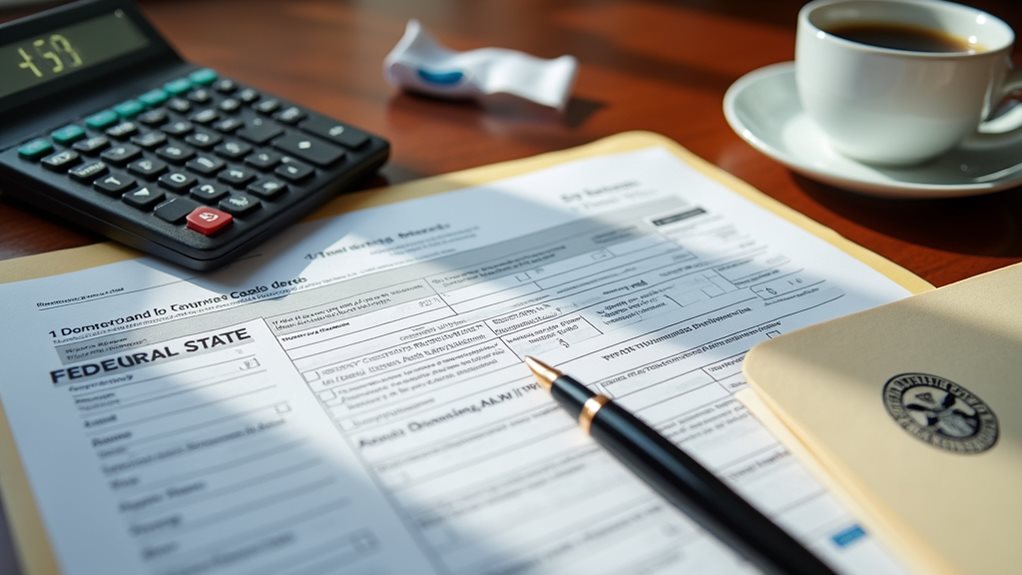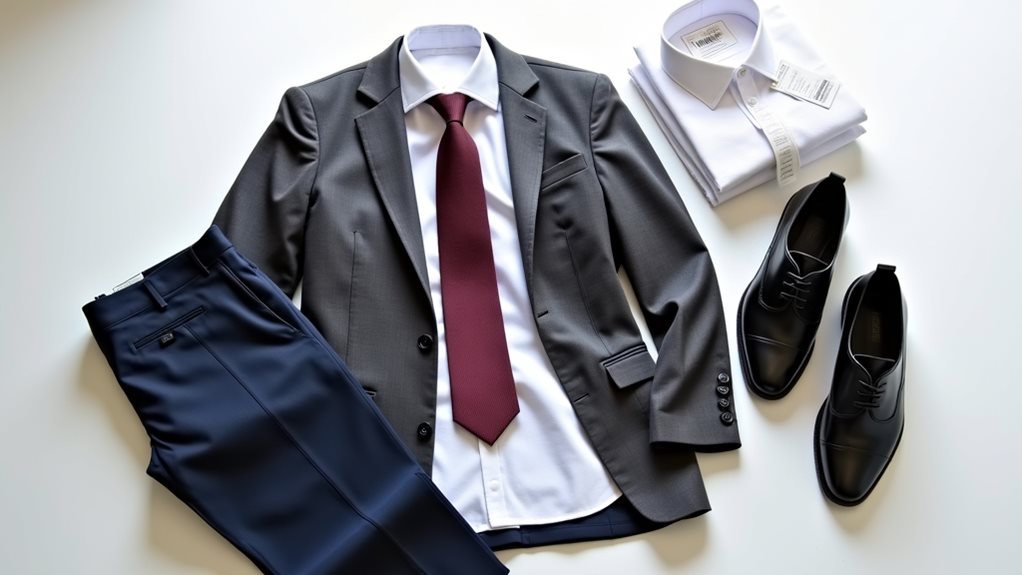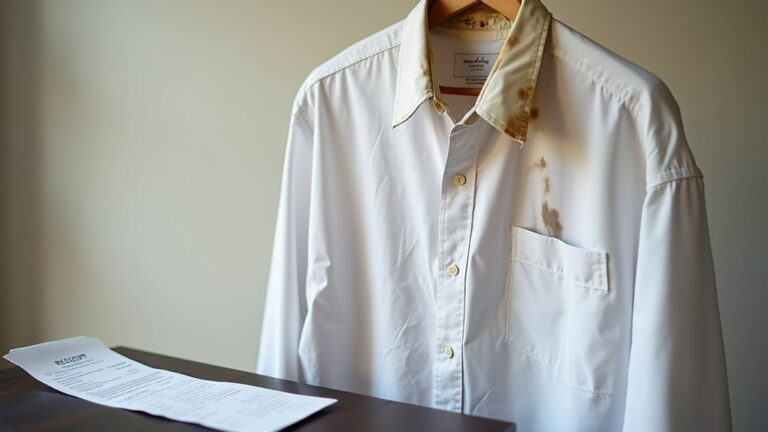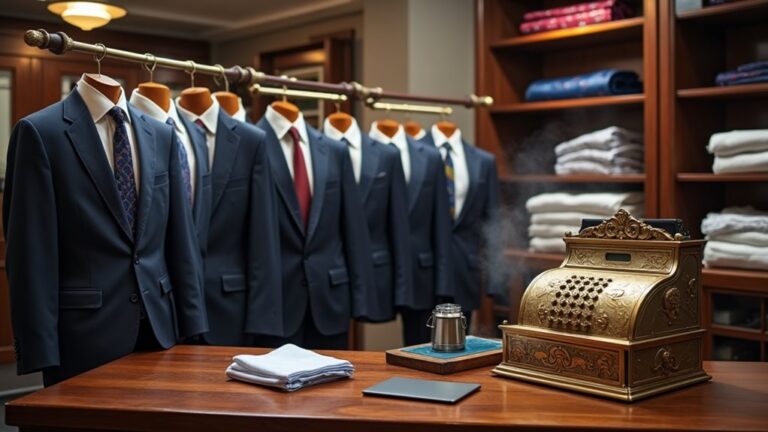You can’t claim unlimited dry cleaning expenses, and the IRS doesn’t set specific dollar caps but requires your clothing to meet strict criteria: it must be required for work and unsuitable for everyday wear. If you’re self-employed, you’ve got more flexibility to deduct qualifying uniforms and specialized gear, while employees face suspended deductions until 2026. The key isn’t how much you spend, but whether your garments truly qualify under federal guidelines, and proper documentation will reveal the secrets to maximizing your legitimate claims.
Understanding IRS Rules for Clothing Deductions
When I first started my consulting business years ago, I made the classic rookie mistake of thinking I could deduct the dry cleaning costs for my favorite navy blazer simply because I wore it to client meetings, but the IRS had other plans for my optimistic tax strategy.
Here’s what I learned the hard way: the IRS requires clothing expenses to meet two strict criteria for tax deductions. Your clothing must be required for your job AND unsuitable for everyday wear – both conditions matter.
If you’re self-employed, you can still claim these business expenses on your federal tax return, but employees can’t deduct dry cleaning until 2026.
That navy blazer? Definitely wearable outside work, so it didn’t qualify as deductible. 😅
Examples of qualifying clothing include protective gear, specialized uniforms with company logos, or costumes required for performers, while keeping detailed receipts is essential for proper documentation when claiming these deductions.
The Two-Prong Test for Deductible Garments

Although the IRS doesn’t make it easy to understand, the Two-Prong Test fundamentally acts as a gatekeeper that determines whether your dry cleaning bills can become legitimate business deductions on your tax return.
Think of this test as your clothing expenses’ strict bouncer – both requirements must be satisfied, or you’re not getting past the velvet rope. Your deductible garments need to be necessary for employment AND unsuitable for everyday wear, which honestly sounds simpler than it actually is in practice.
Here’s what qualifies under the Two-Prong Test:
- Uniforms with company logos or distinctive colors
- Specialized gear like hazmat suits or protective clothing
- Costumes for performers or entertainment workers
- Religious vestments for clergy members
- Safety equipment requiring professional cleaning
Business suits? Unfortunately, they’re considered non-deductible clothing since you could theoretically wear them anywhere. 😅
It’s essential to maintain proper record-keeping practices and documentation to support your dry cleaning deductions in case of an IRS audit.
Federal Vs State Tax Treatment of Dry Cleaning Expenses

Since the Tax Cuts and Jobs Act of 2018 threw a wrench into everyone’s deduction plans, you’ll find yourself maneuvering a frustrating maze where federal and state tax laws treat your dry cleaning expenses completely differently.
While federal rules suspended employee deductions until 2026, many states still welcome these claims with open arms—it’s like your state government decided to throw you a lifeline while Uncle Sam went fishing 🎣.
If you’re self-employed, you’ve got better luck with federal eligibility since those business expense rules remain intact.
The key is understanding that tax treatment varies dramatically between jurisdictions, so you’ll need to research your specific state’s tax rules carefully before claiming any dry cleaning deductions on either return.
Remember that even when deductions are allowed, you must maintain detailed records including receipts and documentation proving the business necessity of your dry cleaning expenses.
Employee Vs Self-Employed Deduction Differences

Two completely different tax worlds exist when you’re comparing employee versus self-employed dry cleaning deductions, and honestly, the gap feels wider than the Grand Canyon after recent tax law changes.
As an employee, you’re basically stuck watching your dry cleaning expenses disappear into the void until at least 2026, thanks to federal deduction suspensions that hit harder than a surprise coffee stain on your favorite shirt.
Meanwhile, self-employed folks get to play by different rules, deducting work-related clothing expenses if they pass the IRS’s strict two-prong test requiring clothing that’s necessary for work yet unsuitable for everyday wear.
Given the complexity of these regulations and varying eligibility requirements, consulting with a qualified tax professional can help ensure you’re maximizing your eligible deductions while staying compliant with current IRS rules.
- Employees can’t deduct dry cleaning expenses on federal tax returns currently
- Self-employed individuals must meet IRS criteria for work-specific uniforms
- State tax laws might offer employee exceptions worth exploring
- Business owners can claim employee uniform cleaning costs
- Documentation requirements differ greatly between employment types
Qualifying Work Attire and Professional Requirements

What exactly makes your work clothes different from the blazer hanging in your weekend wardrobe, and why does the IRS care so much about this distinction? The answer lies in qualifying work attire that meets three strict IRS qualifying tests, and honestly, they’re pickier than my grandmother choosing produce 🛍️.
Your clothing must be required by your employer, unsuitable for ordinary street wear, and exclusively worn in your work setting – no sneaking that nurse’s scrub to the grocery store!
Professional requirements demand you can’t use this clothing outside of work, period. Whether you’re an employee or among self-employed individuals, these specific requirements remain unchanged.
The IRS won’t let you deduct dry cleaning unless your attire truly serves only professional purposes. Remember to keep proper receipts and documentation for all qualifying dry cleaning expenses, as the IRS requires detailed records to support your deduction claims.
Documentation and Record-Keeping Requirements

Although the IRS accepts your word that those power suits need professional cleaning, they’ll absolutely want to see the receipts when audit season rolls around.
Trust me, you don’t want to be scrambling through shoeboxes like I did during my first business inspection 📋. Proper documentation transforms your dry cleaning deductions from wishful thinking into bulletproof federal tax returns that’ll withstand any IRS scrutiny.
Essential record-keeping requirements include:
- Maintain all receipts showing dates, amounts, and business use documentation for at least three years
- Keep detailed invoices clearly indicating work-specific clothing being cleaned
- Organize expenses by category when preparing Schedule C submissions
- Store bank statements as backup verification for your dry cleaning expenditures
- Document the exclusive business nature of each garment being professionally cleaned
For expenses under $75, the IRS may not require receipts, but you should still maintain detailed logs documenting the business purpose, date, and amount to support your claims.
Annual Limits and Reasonable Expense Guidelines

You’ll be relieved to know that the IRS doesn’t set specific dollar caps on dry cleaning deductions for self-employed folks, which means you won’t hit some arbitrary ceiling that cuts off your legitimate business expenses.
However, here’s where it gets a bit tricky – your dry cleaning costs need to pass what I call the “reasonableness test,” meaning they should align with your income level and business activities without raising red flags.
Think of it this way: if you’re earning $50,000 annually but claiming $10,000 in dry cleaning expenses, that’s going to look suspicious and might trigger an audit faster than you can say “pressed pants.” 😅
Keep in mind that work uniforms and specialized protective clothing are more likely to qualify for deductions compared to regular business attire that could be worn in personal settings.
No Federal Caps
Unlike many tax deductions that come with strict annual caps and dollar limits, dry cleaning expenses for work clothes don’t have any federal ceiling imposed by the IRS. This means you can potentially deduct every reasonable penny you spend on keeping your qualifying work attire clean and presentable.
This freedom feels invigorating, especially when you’re self-employed and watching every business expense like a hawk 🦅. The IRS simply requires your dry cleaning costs to be reasonable for your profession, without imposing arbitrary dollar restrictions that might leave you scrambling to maximize deductions before year-end.
Remember that business owners can deduct dry cleaning costs for business-related clothing, while employees may only qualify if their employer requires specific uniforms unsuitable for regular wear and they bear the cleaning costs without reimbursement.
- Document every receipt carefully for potential audit protection
- Confirm work clothing meets IRS criteria for specialized attire
- Compare expenses to industry standards for reasonableness
- Separate personal clothing costs from legitimate business deductions
- Maintain detailed records linking expenses to specific work requirements
Reasonableness Income Test
The IRS operates on the principle that your dry cleaning expenses should make sense when viewed alongside your professional income and industry standards, creating an informal but important reasonableness test that can protect you from unwanted scrutiny.
Think of it this way: if you’re earning $40,000 annually but claiming $8,000 in dry cleaning deductions, that’s going to raise eyebrows faster than you can say “audit.” 📊
Self-employed individuals especially need to balance their work clothing expenses with their income level, guaranteeing documentation supports every deductible claim.
The IRS expects reasonable expenses that align with industry norms, so a construction worker claiming thousands for suit cleaning will likely be scrutinized more than a lawyer with similar dry cleaning deductions.
For most professional garments, reasonable amounts typically range from $25-$50 per item depending on local dry cleaning rates and garment complexity.
Common Mistakes to Avoid When Claiming Dry Cleaning Costs

You might think claiming your sharp business suits sounds reasonable, but I learned the hard way that the IRS doesn’t see everyday work clothes as deductible expenses, even when they cost more than my monthly coffee budget ☕.
Don’t make my rookie mistake of tossing receipts in a shoebox and hoping for the best, because without proper documentation, your claims will crumble faster than a cookie in milk.
Most importantly, you’ll need to understand the IRS’s strict tests for what qualifies as deductible clothing, since assuming your dry cleaning bills automatically count as business expenses can lead to some uncomfortable conversations with tax authorities.
The key distinction lies in whether you’re cleaning specialized work clothing that cannot be worn for everyday use, such as uniforms or professional costumes, versus regular business attire that could double as personal clothing.
Claiming Personal Clothing Expenses
When claiming personal clothing expenses becomes tempting territory, I’ve watched countless taxpayers stumble into the same costly traps, convinced their sharp business suits and professional wardrobe deserve tax breaks that simply don’t exist.
The IRS maintains strict guidelines that make most clothing expenses non-deductible, especially for employees who face suspended deductions until 2026.
Your everyday work attire rarely qualifies because it’s suitable for personal wear outside the office, which violates the exclusivity requirement that tax laws demand.
- You can’t deduct dry cleaning costs for suits, dress shirts, or professional clothing worn to regular office jobs
- Personal clothing remains non-deductible even if your employer requires specific dress codes or uniforms
- The “exclusively for work” test means if you’d wear it anywhere else, it doesn’t qualify
- Missing receipts eliminate any chance of claiming legitimate clothing expenses during audits
- State tax laws might offer different rules, so research local deduction opportunities 💼
Missing Required Documentation
Beyond understanding which expenses qualify, proper documentation becomes the make-or-break factor that separates successful deductions from audit nightmares. I’ve seen too many business owners learn this lesson the hard way when faced with shoebox receipts and faded cleaning tickets.
You can’t just claim dry cleaning costs without maintaining detailed records that clearly show dates, amounts, and service types. The IRS criteria demands you distinguish between personal expenses and qualifying work attire, which means your business suits better have documentation proving they’re non-deductible unless they meet specific requirements.
Keep those receipts organized for at least three years post-filing – trust me, during an audit, scrambling through random papers while explaining why you can’t find proper documentation isn’t the conversation you want to have with the IRS! 📋
Ignoring IRS Tests
Although I’ve watched countless clients confidently stride into my office claiming thousands in dry cleaning deductions, most crumble when I explain the IRS’s notorious two-prong test that governs clothing expenses – and honestly, it breaks my heart every time because these folks genuinely believed their crisp business suits qualified for write-offs.
You can’t ignore IRS rules when claiming work-related expenses, because that gorgeous business attire doubles as personal use clothing, making it non-deductible regardless of how professional you look.
- Your expensive suits fail the “not suitable for everyday wear” requirement
- Dry cleaning costs become deductible only for true uniforms or specialized work gear
- Tax miscalculations from ignoring these tests trigger audit penalties that’ll make you wince
- Professional dresses and blazers don’t magically transform into legitimate deductions
- Self-employed individuals face identical restrictions despite different filing requirements




